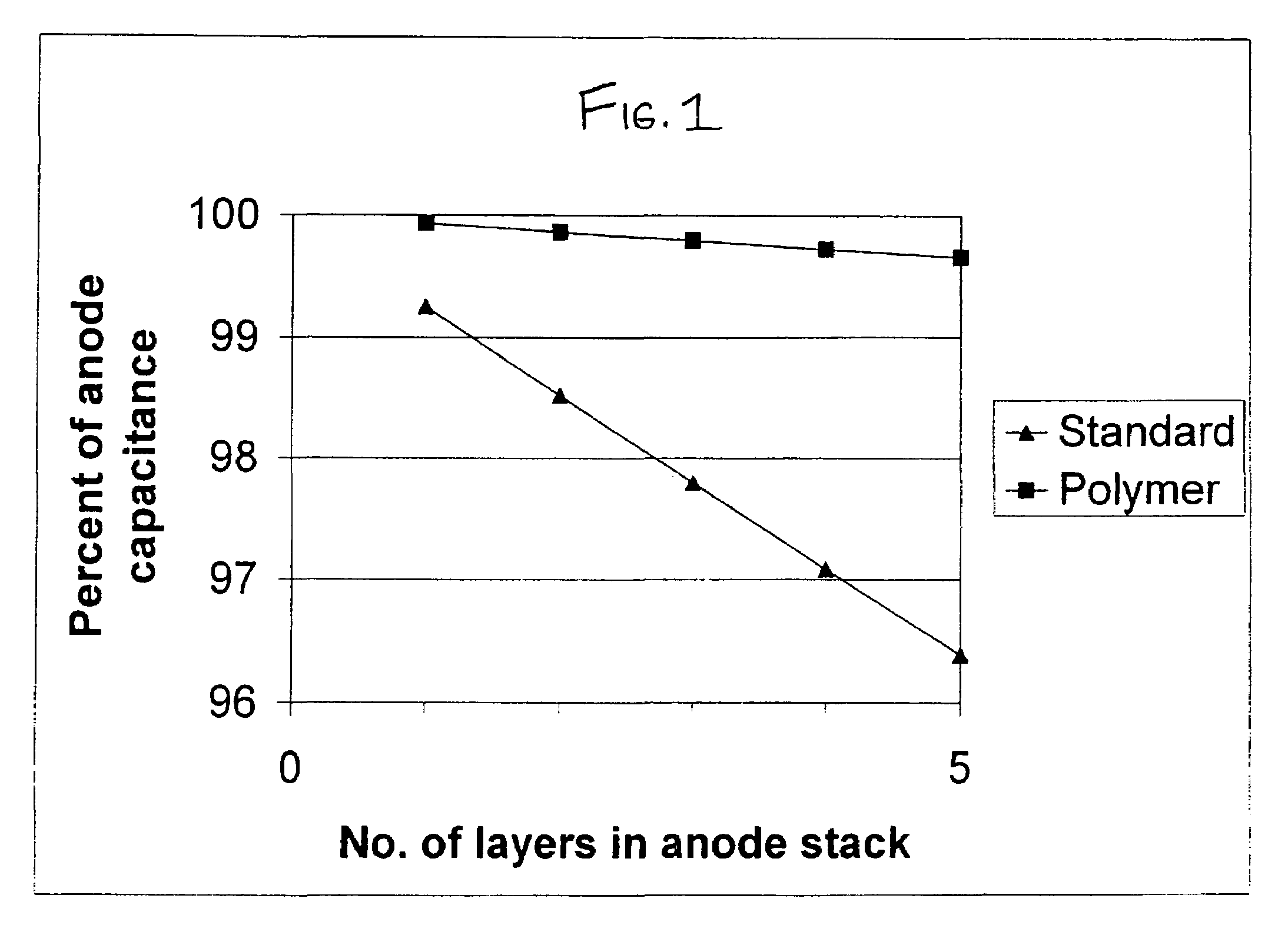High surface area cathode for electrolytic capacitors using conductive polymer
- Summary
- Abstract
- Description
- Claims
- Application Information
AI Technical Summary
Benefits of technology
Problems solved by technology
Method used
Image
Examples
example 1
[0040]Titanium foil was cut into 4 cm2 samples and cleaned in a 5% oxalic acid solution at 90° C. for two minutes. A 100 ml solution was prepared of 0.5 M 3,4 ethylenedioxythiophene (EDOT) and 0.1 M tetraethylammonium tetrafluoroborate in acetonitrile.
[0041]The titanium foils were exposed to the solution at room temperature at varying current densities and times, as shown in Table 1 below, and the capacitance and ESR were observed.
[0042]
TABLE 1Current DensityExposure timeCapacitance(mA / cm2)(min)(mF)ESR (Ω)0.8058.433.81621.25513.863.61881.60518.13.91041.75812.053.80881.60811.953.8909
example 2
[0043]A coating solution was prepared with 0.13 M 3,4 ethylenedioxythiophene, 0.026 M tetraethylammonium tetrafluoroborate and 0.08 M lithium perchlorate (LiClO4) in 150 ml acetonitrile.
[0044]Titanium foil samples of 4 cm2 size were exposed to the solution while nitrogen was bubbled. Two current densities were examined. In the first experiment, a galvanic square wave was applied with the following set points: 1 mA (0.25 mA / cm2) for 120 sec, 2 mA (0.5 mA / cm2) for 420 sec and 1 mA (0.25 mA / cm2) for 60 sec. Three cycles were performed. In the second experiment, the foil was exposed to a 2 mA (0.5 mA / cm2) current for 15 minutes. After both treatments were complete, capacitance and ESR were observed on the foils (a) initially, (b) after an acetone rinse followed by a methanol rinse and one hour oven dry, and (c) after a two day air dry, as shown in Table 2 below.
[0045]
TABLE 2CapacitanceTreatmentTime Measured(mF)ESR (Ω)Galvanic SquareInitial9.153.9475WaveGalvanic SquareAfter rinse and6.37...
example 3
[0047]In a further experiment, the coating solution of Example 2 was used to coat additional 4 cm2 titanium foil samples. Varying current densities and exposure times were examined and capacitance and ESR values were obtained immediately after coating and after rinses with acetone and methanol and a 60 minute oven dry, as shown in Table 3A below. Nitrogen was bubbled during coating.
[0048]
TABLE 3ACurrentDensityExposureCapacitance(mA / cm2)Time (min)Measurement(mF)ESR (Ω)0.510Initial10.96.38800.510After rinse and8.236.202160 min. ovendry0.515Initial13.55.77300.515After rinse and10.925.845460 min. ovendry1.010Initial12.26.58441.010After rinse and11.06.267060 min. ovendry1.015Initial15.05.91701.015After rinse and10.695.903260 min. ovendry1.510Initial15.46.67581.510After rinse and13.45.800060 min. ovendry1.515Initial13.86.73711.515After rinse and10.356.014860 min. ovendry
[0049]The polymer cathode samples from Examples 2 and 3 were stored in a 65° C. oven for five days. After storage, the c...
PUM
| Property | Measurement | Unit |
|---|---|---|
| Percent by mass | aaaaa | aaaaa |
| Percent by mass | aaaaa | aaaaa |
| Percent by mass | aaaaa | aaaaa |
Abstract
Description
Claims
Application Information
 Login to View More
Login to View More - R&D
- Intellectual Property
- Life Sciences
- Materials
- Tech Scout
- Unparalleled Data Quality
- Higher Quality Content
- 60% Fewer Hallucinations
Browse by: Latest US Patents, China's latest patents, Technical Efficacy Thesaurus, Application Domain, Technology Topic, Popular Technical Reports.
© 2025 PatSnap. All rights reserved.Legal|Privacy policy|Modern Slavery Act Transparency Statement|Sitemap|About US| Contact US: help@patsnap.com

